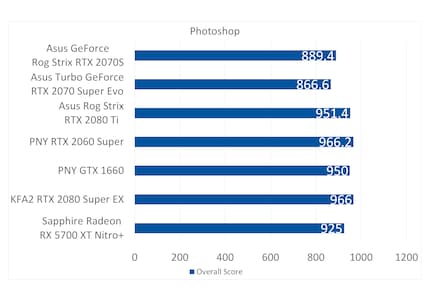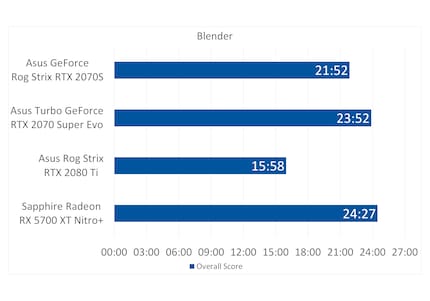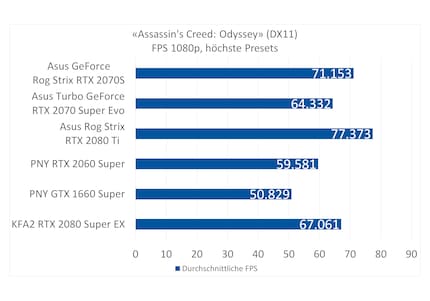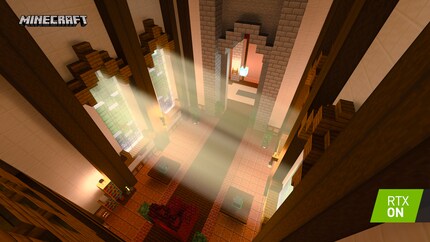
Product test
Axial vs. radial: Two GeForce RTX 2070 Super in a ray tracing comparison test
by Kevin Hofer

Does it always have to be the expensive one? Two GeForce RTX 2070 Super graphics cards compete against each other: The high-end model from Asus Rog Strix against the standard model with blower fan, also from Asus. In the second part of the comparison test, I test the cards in applications and games and take a look at the "Minecraft RTX" beta.
The result of the first part of the graphics card comparison is summarised appropriately by user claudenobs:
well, 5-10% more performance in synthetic benchmarks at an additional price of 10% is not an exhilarating result.
These results refer to synthetic benchmarks. What about the actual values in games and applications?
As a reminder, the graphics cards are tested on our test bench with the following components:
The Photoshop benchmark uses the following reference workstation as the basis for calculating the scores:
The results of the reference workstation can be used to estimate how well other systems perform. Our test benchmark with the two GeForce RTX 2070 Super achieves the following results:

Here are the results in detail:
Both GeForce RTX 2070 Super scores drop in the Photoshop benchmark. I have to mention that I switched to the 2020 version of Photoshop because I had to reset the tested benchmarks. I was previously using the 2019 version. A comparison with the other cards should therefore be treated with caution, as the results are not one hundred per cent comparable. The GeForce RTX 2070 Super only really drops in the filter score, which also lowers the overall score accordingly. In terms of performance, the two cards are only separated by 2.5 per cent.
After what felt like an eternity of not running the Blender benchmark with the Nvidia RTX graphics cards, it is now doing so again in the latest version. As soon as I get round to it, I'll test all the cards again in Blender and give you an overview.

The Strix beats the Turbo by two minutes. The higher clock rate is clearly noticeable here.
In response to reader feedback, I have revised the games section. Instead of four games, there are now nine games in the test pool. I have completely removed "Crysis 3" and "Control" because they have no in-game benchmarks. I will provide results for the 5700X Nitro+ from Sapphire in a later graphics card review.
You can find the graphics of the frametime measurement as a download under this link.

The Strix performs better than the Turbo in all games. The differences range from hardly any - not even an FPS difference in "Red Dead Redemption 2" in 1440p to eleven per cent - "Assassin's Creed: Odyssey" in 1080p. On average, the difference between the two maps is around three per cent.
In the first part of the comparison test, I took an in-depth look at ray tracing in "Wolfenstein: Youngblood". I'm doing the same this time with "Minecraft RTX" in beta.
One thing is certain: "Minecraft" has never looked so good. Not surprising, because "Minecraft RTX" utilises all of Nvidia's ray tracing functions. Unlike in previous games, ray tracing in "Minecraft" is not a rasteriser-ray tracing hybrid, but a classic patch tracing.
With RTX, the developers also had to incorporate material properties that go beyond the two standard values of "Minecraft": Colour and Opacity. In the ray tracing version, the blocks are given four additional new properties: metallic, normal, roughness and (light) radiance.
Of course, patch tracing has an impact on performance. That's why DLSS (Deep Learning Super Sampling) is on board, just like in "Wolfenstein: Youngblood". This is the latest version of Nvidia's AI-based upscaling technology.
According to Nvidia, DLSS should lead to a 1.7-fold increase in performance when playing in 1080p with "Minecraft RTX". DLSS 2.0 is automatically activated when ray tracing is active. The game automatically selects whether quality or performance should be prioritised.
After signing up for the beta, I download six Nvidia RTX ray tracing worlds from the Marketplace. First, I jump into the "Crystal Palace RTX" world. Wow, it looks really cool. This is not the "Minecraft" I know. I measure the frames with my FPS counter while exploring. It's 64 in 1080p.
I take a closer look at the settings. There aren't that many options - Minecraft never had them. Why would it? The game consists of huge blocks of pixels. That's what makes it so charming. I do find one setting: "Ray Tracing Render Distance". This setting determines how far the environment is rendered. The default setting is "8 chunks", the lowest setting. I turn it up to the maximum, 24 chunks. Cool, now I have a clear view of the Mediterranean. The frame rate suffers a little, but the average is still 53 FPS.
I try a different world. "Neon District RTX" looks great. The frame rate is a little lower here: I measure an average of 54 FPS with 8 chunks. I turn it up to 24. Wow, now the whole thing looks even cooler. Unfortunately, the frame rate drops to an average of 32 FPS. As it is "Minecraft", the game is playable, but unusually jerky. I play in the first-person perspective. If I switch to third person, the average FPS even drops below 20. Unfortunately, I can no longer play like this.
"Minecraft RTX" gives a glimpse of what games with full ray tracing could look like. Depending on the settings and complexity of the world, the hardware isn't quite ready yet. With a GeForce RTX 2070 Super - I used the Turbo - the game runs great in 1080p with a limited view. Incidentally, the graphics card is the decisive factor for "Minecraft RTX" as Tom's Hardware shows in a short test. Even an older processor should be able to cope with the game. I'll certainly be spending a few more hours in the dazzling pixel world.

The comparison test shows: The performance differences between the two GeForce RTX 2070 Super are not huge. Most people can live with the few frames less in games and the barely noticeable differences in everyday applications.
The fact from the first part of the comparison test that the Strix runs more quietly and gets less hot remains. As soon as I get my hands on a mini-ITX case, I'll test both cards in it. Let's see to what extent the Turbo can play to its strengths there and how the tight space conditions affect the Strix.
From big data to big brother, Cyborgs to Sci-Fi. All aspects of technology and society fascinate me.